With regard to the emergence of plants, evolutionists claim that the hundreds of thousands of varieties of plants all emerged from one single plant. There is no doubt that, as with other subjects, evolutionists can offer no scientific evidence to support their claims in this matter. Because the dead-end evolutionists find themselves in with regard to animals and human beings, is the same dead-end they arrive at with their scenarios of the evolution of plants.
 |
The greatest dead end that defenders of the evolution of plants come up against today is, without doubt, their inability to explain how the first plant cell evolved. Actually, the greatest dead-end evolutionists find themselves up against on every subject, - not just that of the evolution of plants, - is definitely the question of how the first cell came about.
It is known that cells are tiny living structures and that possess very complex systems. Yet there are many points that are not fully understood today regarding how these systems function. A cell has complex structures resembling a huge factory. If just one organelle is missing, or is different from what should be, the cell cannot perform its functions. Because every organelle has a particular function, and has very complex links with other organelles. There are very complex structures within the cell, from those which create energy to units where all the information regarding the cell is recorded, from transportation systems which enable substances to reach the parts where they are needed, to parts where incoming substances are broken down and parts which produce enzymes and hormones.
In the face of these structures, the evolutionist scientist W.H. Thorpe reveals his amazement in the following statement:
The most elementary type of cell constitutes a "mechanism" unimaginably more complex than any machine yet thought up, let alone constructed, by man.62
One of the scientists who cannot ignore the extraordinary structure of the cell is the Russian evolutionist Alexander Oparin. Oparin describes the situation in which the theory of evolution finds itself in the face of the complexity of the cell:
Unfortunately, the origin of the cell remains a question which is actually the darkest point of the complete evolution theory.63
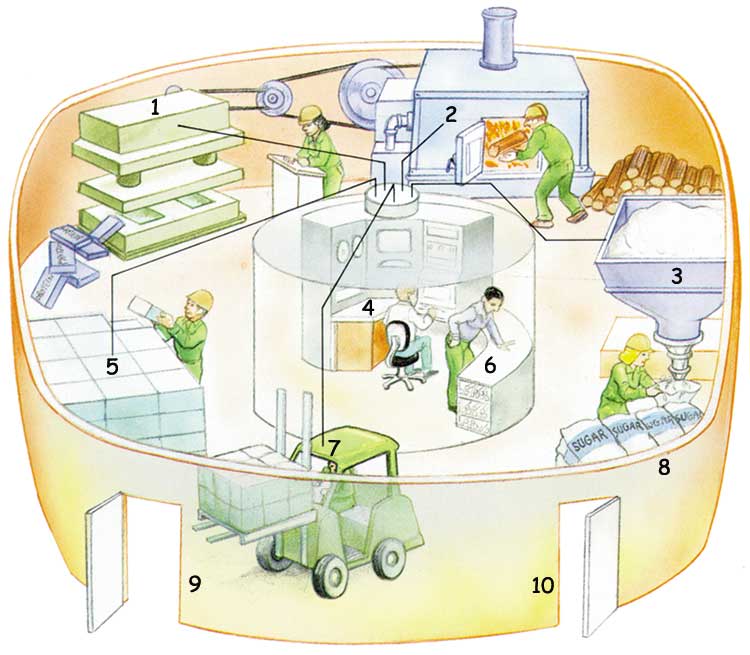 | |
| 1- Ribosomes | 6- Chromosomes |
| Living cells can be compared to big factories with energy-producing and packaging centres, transportation systems, data banks, and special sections where chemical processes are carried out. The only obvious difference between a cell and a factory is without doubt the cell's microscopic size. | |
It is quite impossible for a living cell to come about by chance. The science of the 20th century having revealed the unbelievable complexity in the cell shows that the emergence of such a structure by coincidence is completely beyond the bounds of possibility. And furthermore, even at the start of the 21st century, many of the secrets of the cell have still not been uncovered by modern science. Far from the cell's emerging by coincidence, a living cell, even an artificial one, cannot be produced in laboratories equipped with the most highly developed technology, even with massive expenditure of effort by expert scientists with years of experience.
As a result, even one living cell leads us to a definite and unquestionable conclusion: It must have come about as a result of creation by God, who possesses infinite intelligence and might: everything is the work of His matchless artistry and knowledge.
In this section, the subject of how a living cell could not have come about by chance will not be considered in depth. (For detailed information see Harun Yahya, The Miracle in the Cell.) The basic subject which will be considered in this book is that perfectly designed plants could not have developed from a single bacteria cell, as the result of coincidences, as the theory of evolution claims.
Evolutionists claim that, at around the time the Earth was first formed, a bacteria cell emerged by chance, and that after a period lasting millions of years, there emerged from this cell all other living creatures, birds, insects, tigers, horses, butterflies, snakes, squirrels, et al. In the same way, evolutionists claim that all the countless varieties of plants also emerged from the same bacteria cell. In this section, the falsity of these claims, and the fact that they are based on imagination and therefore unscientific, will be examined.
In the plant evolution scenario, it is claimed that the first plant cell developed from a "primitive" bacteria cell. In this scenario the "primitive cell" which is suggested as having evolved is a bacteria cell (prokaryotic cell). Before moving on to the invalidity of this claim, let us examine whether a bacteria cell is "primitive," as claimed by evolutionists, or not.
Bacteria are tiny living things, one micrometer (a thousandth of a millimetre) long, and contain no structures but a cell membrane and a DNA strand. It may seem much simpler than other living things when their structures are compared. But this in no way means that bacteria are primitive forms of life. Inside these tiny cells very important bio-chemical events take place which enable life on Earth to continue. Bacteria play very important roles in the functioning of nature's ecological system in the world. For example, some bacteria species dismantle the remains of dead plants and animals, and turn them into basic chemical substances to be used by living organisms. Some increase the fertility of the soil. They also carry out functions such as turning milk into cheese, producing antibiotics against harmful bacteria, and synthesising vitamins.
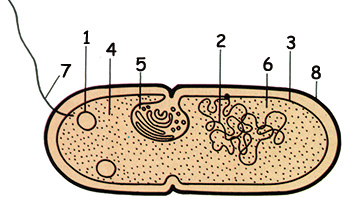 | 1. Plasmid | 5. Mesosome |
| Prokaryotic cells, one of which is seen in plan form here, are bacteria-resembling cells with few organelles in them. It is impossible, of course, for all living things to have evolved out of such a simple cell, as evolutionists claim. | ||
These are only a few of the countless tasks carried out by bacteria. Although the cells of the bacteria which carry all this out appear simple, when they are examined it is seen that they are not so at all. A bacterium has about 2,000 genes. Each gene has about 1000 letters (links) in it. So the bacterium's DNA must be at least 2 million letters in length. What does this mean? According to this calculation, the information in the DNA of one bacterium is equivalent to 20 average novels, each of 100,000 words.64
Any change in the information in the DNA code of a bacterium would be so deleterious as to ruin the bacterium's entire working system. As we have seen, a fault in the bacteria's genetic code, means that the working system would go wrong. In other words, that the bacteria could not live, and could not survive down the generations. As a result, a very important link in the ecological chain of balances would break and all the balances in the world of living things would be turned upside down. When all these complex features are borne in mind, it is obvious that bacteria are not primitive cells as the theory of evolution claims. Furthermore, the evolution of bacteria into plant and animal cells (eukaryotic cells), as in the evolutionists' claim, is something which breaks every kind of biological, physical, and chemical law. Although they are fully aware of this impossibility, defenders of the theory of evolution will not give up defending this theory, which they invented out of their own hopelessness. Even so, they sometimes cannot resist talking about the theory's invalidity. For example, the famous Turkish evolutionist Professor Ali Demirsoy admits that bacterial cells, which are claimed to be primitive, cannot turn into eukaryotic cells:
One of the most difficult stages to be explained in evolution is to scientifically explain how organelled and complex cells developed from these primitive creatures. No transitional form has been found between these two forms. One and multi-celled creatures carry all this complicated structure, and no creature or group has yet been found with organelles of a simpler construction in any way, or which are more primitive. In other words, the organelles carried forward are developed by all means. They have no simple and primitive forms.65
The question: "What is it that encourages the evolutionary scientist, Professor Ali Demirsoy, to make such an open admission?" may come to mind. The answer to this question can be given quite clearly when the great structural differences between bacteria and plant cells are examined:
1. While the walls of bacterial cells are formed of polysaccharide and protein, the walls of plant cells are formed of cellulose, a totally different structure.
2. While plant cells possess many organelles, covered in membranes and possessing very complex structures, bacterial cells lack typical organelles. In bacteria cells there are just freely moving tiny ribosomes. But the ribosomes in plant cells are larger and are attached to the cell membrane. Furthermore, protein synthesis takes place by different means in the two types of ribosomes.66
3. The DNA structures in plant and bacterial cells are different.
4. The DNA molecule in plant cells is protected by a double-layered membrane, whereas the DNA in bacterial cells stands free within the cell.
5. The DNA molecule in bacterial cells resembles a closed loop; in other words, it is circular. In plants, the DNA molecule is linear.
6. There is relatively little protein in the DNA molecule in bacterial cells. But in plant cells the DNA molecule is linked from one end to the other by proteins.
7. The DNA molecule in bacterial cells carries information belonging to just one cell, but in plant cells the DNA molecule carries information about the whole plant. For example, all the pieces of information about a fruit-bearing tree's roots, stem, leaves, flowers, and fruit are all found separately in the DNA in the nucleus of just one cell.
8. Some species of bacteria are photosynthetic, in other words, they carry out photosynthesis. But unlike plants, in photosynthetic bacteria (cyanobacteria, for instance), there is no chlorophyll and photosynthetic pigments. Rather, these molecules are buried in various membranes all over the cell.
9. The biochemical structures of mRNAs in bacterial cells and in plant/animal cells are quite different from one another.67
The mRNA, or messenger RNA, is perhaps the most important of the three types of RNA. DNA does not directly synthesize protein. It synthesizes the mRNA molecule, which contains the information necessary for the production of polypeptide amino acid chains. When this information contained by mRNA reaches the relevant place, and proteins are produced from the amino-acid building blocks.
 |
| They repudiated them wrongly and haughtily, in spite of their own certainty about them. Consider the final fate of the corrupters. |
Messenger RNA plays a vital role for the cell to live. But although messenger RNA assumes the same vital role in both prokaryotic (bacterial) cells and in eukaryotic (including plant and animal) cells, their biochemical structures are different. An article by J. Darnell published in Science says:
The differences in the biochemistry of messenger RNA formation in eukaryotes compared to prokaryotes are so profound as to suggest that sequential prokaryotic to eukaryotic cell evolution seems unlikely.68
The structural differences between bacterial and plant cells, of which we have seen a few examples above, lead evolutionist scientists to another dead end. Although plant and bacteria cells have some aspects in common, most of their structures are quite different from one another. In fact, since there are no membrane-surrounded organelles or a cytoskeleton (the internal network of protein filaments and microtubules) in bacterial cells, the presence of several very complex organelles and cell organization in plant cells totally invalidates the claim that the plant cell evolved from the bacterial cell.
Biologist Ali Demirsoy openly admits this, saying "Complex cells never developed from primitive cells by a process of evolution." 69
Although it is definitely impossible for plant cells to have evolved from a bacteria cell, evolutionist scientists have tried to ignore this fact and have put forward a large number of debatable hypotheses. But experiments overturn these hypotheses. The most popular of these is the "endosymbiosis" hypothesis.
This hypothesis was put forward by Lynn Margulis in 1970 in her book The Origin of Eukaryotic Cells. In this book, Margulis claimed that as a result of their communal and parasitic lives, bacterial cells turned into plant and animal cells. According to this theory, plant cells emerged when a photosynthetic bacterium was swallowed by another bacterial cell. The photosynthetic bacterium evolved inside the parent cell into a chloroplast. Lastly, organelles with highly complex structures such as the nucleus, the Golgi apparatus, the endoplasmic reticulum, and ribosomes, evolved, in some way or other. Thus, the plant cell was born.
As we have seen, this thesis of the evolutionists is nothing but a work of fantasy. Despite its fairy-tale nature, it was essential, from the evolutionists' point of view, that this scenario be put forward; evolutionists had to be able to explain how the most vital reactions, such as photosynthesis, in the living world came about, in a structure as complicated as the plant cell. This theory of Margulis appeared to be more advantageous than other claims, because it was based on a feature possessed by the cell. For this reason, many evolutionist scientists saw the thesis put forward by Margulis as a means of escape from the dead-end.
Evolutionists defended this theory on the basis of one feature of plant cells. This feature, when considered on its own, without taking the whole of the cell into account, is one which was very useful for deceiving people who do not possess much information on the subject. Unsurprisingly, it was criticized by scientists who carried out very important research on the subject on a number of grounds: We can cite D. Lloyd, M. Gray and W. Doolittle, and R. Raff and H. Mahler as examples of these.70
The endosymbiosis hypothesis is based on the fact that the mitochondria of animal cells and the chloroplasts of plant cells contain their own DNA, separate from the DNA in the nucleus of the parent cell. So on this basis, it is suggested that mitochondria and chloroplasts were once independent, free-living cells. However, when chloroplasts are studied in detail, it can be seen that this claim is nothing but a scenario. The points which invalidate Margulis' endosymbiosis hypothesis are as follows:
1. If chloroplasts were engulfed by a large cell when, in the past, they were independent cells, that could only have one outcome: namel, it would have been digested by the parent cell and used as food. This must be so, because even if we assume that the parent cell in question took such a cell into itself from the outside by mistake, instead of intentionally ingesting it as food, nevertheless, the digestive enzymes in the parent cell would have destroyed it. Of course, some evolutionists have gotten around this obstacle by saying, "The digestive enzymes had disappeared." But this is a clear contradiction, because if the cell's digestive enzymes had disappeared, then the cell would have died from lack of nutrition.
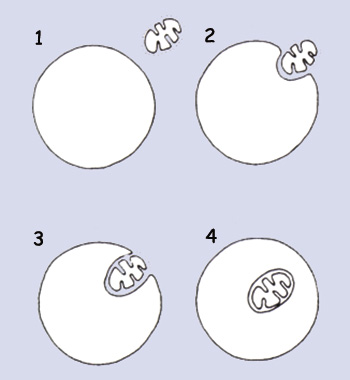 |
| Evolutionists' account of the emergence of plant cells can be summed up in this schematic explanation. |
2. Again, let us assume that all the impossible happened and that the cell which is claimed to have been the ancestor of the chloroplast was swallowed up by the parent cell. In this case we are faced with another problem: the blueprints of all the organelles inside the cell are encoded in the DNA. If the parent cell were going to use other cells it swallowed as organelles, then it would be necessary for all of the information about them to be already present and encoded in its DNA. The DNA of the swallowed cells would have to possess information belonging to the parent cell. Not only is such a situation impossible, the complements of DNA belonging to the parent cell and the swallowed cell would also have to become compatible with each other afterwards, which is also clearly impossible.
3. There is great harmony within the cell, which random mutations cannot account for. There are more than just one chloroplast and one mitochondrion in a cell. Their number rises and falls according to the activity level of the cell, just like with other organelles. The existence of DNA in the bodies of these organelles is also of use in reproduction. As the cell divides, all of the numerous chloroplasts divide too, and the cell division happens in a shorter time and in a more swift fashion.
4. Chloroplasts are energy generators of absolutely vital importance to the plant cell. If these organelles did not produce energy, many of the cell's functions would not work, which would mean that the cell could not live. These functions which are so important to the cell take place with the proteins synthesized in the chloroplasts. But the chloroplasts' own DNA is not enough to synthesize these proteins. The greater part of the proteins are synthesized using the parent DNAin the cell nucleus.71
While the situation envisioned by the endosymbiosis hypothesis is occurring through a process of trial and error, what effects would this have on the DNA of the parent cell? As we have seen, any change in a DNA definitely does not result in a gain for that organism; on the contrary, any such mutation would certainly be harmful. In his book, The Roots of Life, Mahlon B. Hoagland explains the situation:
You'll recall we learned that almost always a change in an organism's DNA is detrimental to it; that is, it leads to a reduced capacity to survive. By way of analogy, random additions of sentences to the plays of Shakespeare are not likely to improve them!... The principle that DNA changes are harmful by virtue of reducing survival chances applies whether a change in DNA is caused by a mutation or by some foreign genes we deliberately add to it.72
The claims put forward by evolutionists are not based on scientific experiments, because no such thing as one bacterium swallowing another one has ever been observed. Evolutionist scientist P. Whitfield describes the situation in this way:
Prokaryotic endocytosis is the cellular mechanism on which the whole of S.E.T. (Serial Endosymbiotic Theory) presumably rests. If one prokaryote could not engulf another it is difficult to imagine how endosymbioses could be set up. Unfortunately for Margulis and S.E.T., no modern examples of prokaryotic endocytosis or endosymbiosis exist… 73
In fact, all the impossibilities we have examined so far are enough to prove the invalidity of the evolution of plants scenario. But one single question will bring all the evolutionists' claims tumbling down without the need for all these explanations:
How did the process of photosynthesis, which has nothing resembling it in the whole world, come about?
According to the theory of evolution, in order to carry out photosynthesis, plant cells swallowed bacterial cells which could photosynthesize and turned them into chloroplasts. So, how did bacteria learn to carry out such a complicated process as photosynthesis? And why had they never done so before that point? As with other questions, evolutionary theory has no scientific answer to give. Have a look at how an evolutionist publication answers the question:
The heterotroph hypothesis suggests that the earliest organisms were heterotrophs that fed on a soup of organic molecules in the primitive ocean. As these first heterotrophs consumed the available amino acids, proteins, fats, and sugars, the nutrient soup became depleted and could no longer support a growing population of heterotrophs. …Organisms that could use an alternate source of energy would have had a great advantage. Consider that Earth was (and continues to be) flooded with solar energy that actually consists of different forms of radiation. Ultraviolet radiation is destructive, but visible light is energy-rich and undestructive. Thus, as organic compounds became increasingly rare, an already-present ability to use visible light as an alternate source of energy might have enabled such organisms and their descendents to survive. 74
The book, Life on Earth, another evolutionist source, tries to explain the emergence of photosynthesis in this way:
The bacteria fed initially on the various carbon compounds that had taken so many millions of years to accumulate in the primordial seas. But as they flourished, so this food must have become scarcer. Any bacterium that could tap a different source of food would obviously be very successful and eventually some did. Instead of taking ready-made food from their surroundings, they began to manufacture their own within their cell walls, drawing the necessary energy from the sun.75
These imaginary fantasies, no different from fairy tales, go completely beyond the bounds of intelligence and science. The actual meaning of these few explanatory sentences emerges when considered for a few seconds in the light of intelligence and science.
 |
| If you ask them, 'Who created the heavens and the earth and made the sun and moon subservient?' they will say, |
First of all, the inevitable end of any living thing which cannot find food is death. The only thing that varies is how long each living thing can survive starvation. After remaining hungry for a length of time, all the functions of every living thing start to cease because they cannot obtain energy by burning food. There is no need to be a scientist to see the truth of this. Anyone can understand this through simple observation. But evolutionist scientists expect that a living thing, whose every function has ceased, can develop a new method of feeding over time and then implement it. They furthermore believe that it can "decide" to develop such a new system and then "begin to produce it" in its own body. If evolutionist scientists carry out an experiment and wait to see whether such a thing happens, the outcome is very clear: The bacteria will soon die.
Another problem facing evolutionist scientists who expect bacteria to produce their own food is the difficulty of the endeavour. In the preceding sections we stressed that photosynthesis depends upon very complex systems. And of all the processes known in the world, this is really the most complicated, its general outlines having been only partly uncovered in our day; many of its stages are still a mystery to man.
This is what evolutionist scientists expect of a dying bacteria: that it should by itself develop this process - a process which has not been artificially reproduced even in reactors with the most highly developed technology.
One of the most striking admissions that such a complicated event as photosynthesis could not have evolved over time is again made by Professor Ali Demirsoy:
Photosynthesis is a rather complicated event, and it seems impossible for it to emerge in an organelle inside a cell, because it is impossible for all the stages to have come about at once, and it is meaningless for them to have emerged separately. 76
Another confession on this subject comes from the evolutionist Hoimar von Ditfurth. In his book, Im Anfang War Der Wasserstoff (In the Beginning was Hydrogen) von Ditfurth says that photosynthesis is a process that cannot possibly be learned:
No cell possesses the capacity to 'learn' a process in the true sense of the world. It is impossible for any cell to come by the ability to carry out such functions as respiration or photosynthesis, neither when it first comes into being, nor later in life.77
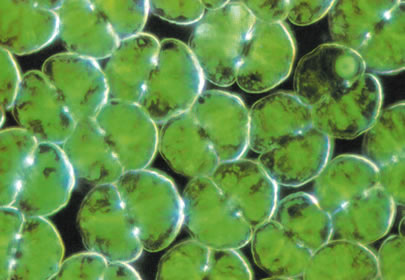 |
| The green algae in the picture are one or multi-celled organisms which can carry out photosynthesis. |
According to the imaginary scenario of evolution, algae, or sea moss, are the ancestors of land plants, and it is suggested that these first evolved some 450 million years ago in the Paleozoic Age. But the fossils which have been discovered in recent years have ruined all the evolutionists' scenarios and their evolutionary family tree.
In Western Australia in 1980, 3.1 to 3.4 billion-year-old fossil reefs were found.78 These consisted of blue-green algae and organisms reminiscent of bacteria. This discovery created the worst kind of chaos for the evolutionists, because it toppled their imaginary evolution tree. According to this tree, algae should have emerged 410 million years ago in the Paleozoic Age. Another interesting point is that the oldest discovered algae had exactly the same complex structures as today's. A scientists investigating the matter said:
The oldest fossils so far discovered are objects fossilized in minerals which belong to blue green algae, more than 3 billion years old. No matter how primitive they are, they still represent rather complicated and expertly organised forms of life.79
And at this point it occurs to one to put this question to the evolutionists:
"How can the theory of evolution, which claims that countless forms of land plants evolved from algae in a period of 100 to 150 million years, explain that algae dated nearly a billion years have exactly the same structure as today's algae?"
Defenders of the theory of evolution ignore this question and others like it, and try to avoid the truth.
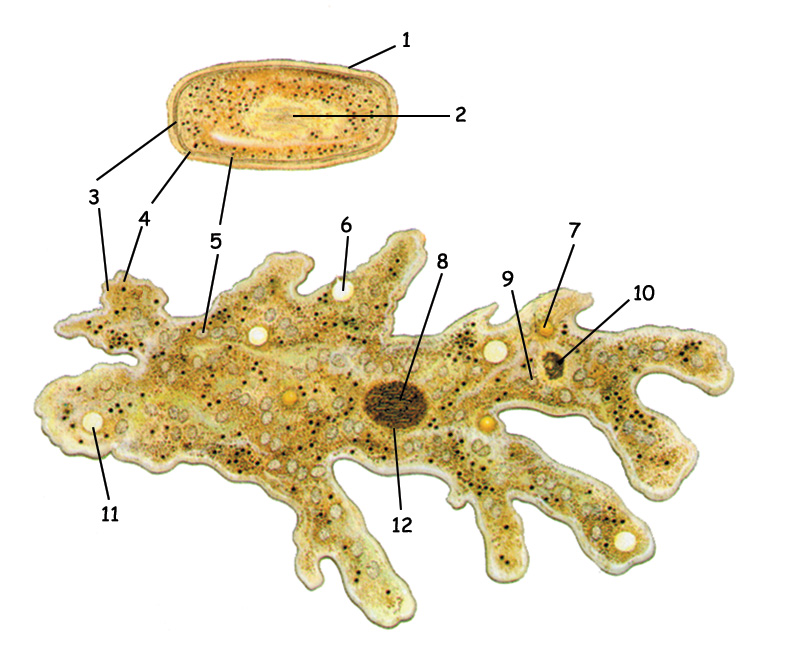 | |
| 1. cell wall | 7. lysosome |
| Evolutionists first claimed that the complex-structured eukaryotic cell emerged from the simple-structured prokaryotic cell, seen at the top, and then formed living things. When they realised that this was not possible, they began to maintain the opposite thesis. | |
Another dead-end for the story of evolution from algae or water moss, is whether prokaryotic algae evolved from eukaryotic algae, or vice versa? Evolutionists disagree among themselves on this matter. They cannot decide on the type of algae. At this point it will be useful to examine cell types in a general way.
Prokaryotic cells resemble bacteria, with no organelles inside them. Whereas eukaryotic cells are animal and plant cells, and have more complex structures than prokaryotic cells. The theory of evolution first claimed that the eukaryotic cell evolved from the prokaryotic. But when evolutionists realised that this was impossible, they changed their minds and began to maintain the opposite. But these claims went no further than being speculation. The quandary that evolutionists found themselves in on the matter is admitted by Robert Shapiro, himself an evolutionist. W.R. Bird writes:
A postulated transition from prokaryotic algae to eukaryotic algae was questioned because the transition was "so fraught with confusion and contradiction that most modern biologists have ignored it." And subsequently was abandoned. The confusion is so great generally that some researchers have proposed that eukaryotes evolved into prokaryotes, rather than the reverse. The fossil evidence is not much more clear. It is clear that prokaryote fossils exist in Precambrian rocks, "but we do not know the time or the circumstances of their origin", Shapiro notes. 80
According to the following sections of the scenario, as a result of the currents in the sea, algae clung to the shores, and began to move inland by turning into land plants shortly thereafter. How close is this assumption of the evolutionists to the truth? Let us have a look.
There are a number of influences that would make it impossible for algae to live after moving on shore. Let us take a brief look at the most important of them.
1. The danger of drying out: For a plant which lives in water to be able to live on land, its surface has first of all to be protected from water loss. Otherwise the plant will dry out. Land plants are provided with special systems to prevent this from happening. There are very important details in these systems. For example, this protection must be such that important gases such as oxygen and carbon-dioxide should be able to leave and enter the plant freely. At the same time, it is important that evaporation be permitted. For such a sensitive system to come about by chance is beyond the realm of possibility: it is impossible. If a plant does not have such a system, it cannot wait millions of years to develop one. In such a situation, the plant will soon dry up and die. The very complexity of these special systems demonstrate the impossibility of their having come about by coincidences over millions, or even billions of years.
2. Feeding: Marine plants take the water and minerals they need directly from the water. For this reason, any algae which tried to live on land would have a food problem. They could not live without resolving it.
3. Reproduction: Algae, with their short life span, have no chance of reproducing on land, because, as in all their functions, algae also use water in dispersing their reproductive cells. Then to be able to reproduce on land, they would need to possess multi-cellular reproductive cells, like those of land plants, which are covered by a protective layer of cells. Lacking these, any algae which found themselves on land would be unable to protect their reproductive cells from danger.
4. Protection from oxygen: Any algae, which arrived on land, would have taken in oxygen in a decomposed form up until that point. According to the evolutionists' scenario, now they would have to take in oxygen in a form they had never encountered before, in other words, directly from the atmosphere. As we know, under normal conditions the oxygen in the atmosphere has a poisoning effect on organic substances. Living things which live on land possess systems which stop them being harmed by it. But algae are marine plants, which means they do not possess the enzymes to protect them from the harmful effects of oxygen. So on reaching land, it would be impossible for them to avoid these effects. Neither is there any question of their waiting for such a system to develop, because they could not survive on land long enough for that to happen.
When these claims of the theory of evolution are looked at from a different point of view, they can be seen to be defective in logic. For example, let us consider the environment algae live in. The water which evolutionists claim they left offers countless possibilities for them to survive. For example, the water protects and insulates them from excessive heat and provides the minerals they need. At the same time it allows them to make their own carbohydrates (sugar and starch) from carbon-dioxide by absorbing sunlight in photosynthesis. In short, water is an ideal environment for algae, both for their physical characteristics and for the systems which carry out their functions. In other words there is no need for algae to leave the water, where they can survive quite comfortably, to live on the land, nor are their general structures suited to such a life.
We can liken this situation to a human being leaving the Earth and going and trying to live on another planet, while he has a perfect environment to live in on Earth (an atmosphere, food, gravity, and many other conditions). Ideally suited as he is to the conditions of this world today, from the moment he leaves the Earth to go to another planet, he will be unable to survive. It is just as impossible for him to go elsewhere as it is for algae to leave the water and start to live on land.
In the face of these truths, evolutionists' traditional gambit is to suggest the fanciful notion that algae adapted themselves to life on land. Whereas it is quite clear to anyone with normal intelligence that algae's doing such a thing as deciding to live on land, bringing about the necessary physical changes to be able to do this within their own structures, and then moving on to the land, is quite out of the question and just an unreasonable fantasy. It is impossible even for man, the most superior of living things, who possesses intelligence, consciousness and will, to bring about any mutations in his body to enable him to live in a different environment. For example, if a man wants to fly, it is inconceivable that he should develop wings, or turn his lungs into gills if he wants to live in the water.
What we are discussing here is algae, which do not have the intelligence, will, power of decision, judgement, or power of evaluation to bring about changes in their own organisms or direct any intervention in them. But how interesting it is that evolutionists fall into the illogicality of ascribing all of these properties to algae, all for the sake of remaining loyal to their theory, and at the price of looking ridiculous.
As we have seen, algae have no chance of going on to land and living there. From the first moment they go on to land they need to have many flawlessly functioning mechanisms to allow them to live there, as land plants do. For these mechanisms to come into existence, they need to have information on them recorded in their own DNA, right from the start. In the experiments he carried out using plants towards the end of the 1800s, the famous biologist Gregor Mendel revealed the genetic laws in living things, and discovered that the features of plants and other living things are carried down to later generations by chromosomes. In other words, every species of living thing maintains its own characteristics in its DNA, from generation to generation.
Finally, the truth which emerges is this: No matter how much time passes, no matter what the conditions, it is impossible for algae to turn into land plants.
The Imaginary Family Tree of Plants | |
 | |
| 1. Plants | 7. Gnetophytes |
As we come to the last act in the evolution scenario, we meet the imaginary evolutionary tree which lies behind all the impossibilities and illogicalities we have seen so far. Plants are divided by evolutionists into 29 classes, and into groups, and into ancestor-descendant relationships. It is claimed that every group evolved from another one, and that bacteria are the common ancestors of all. Flowers, trees and fruits, in their many colours, are the final branches of this tree.
There is one very interesting side to all this. There is not one series of fossils to prove the authenticity of even one branch of this evolutionary tree that you will see in almost any biology book. There are perfect fossil records of many living things in the world, but none of them possess the feature of being an intermediate form between one species and another. They are all completely different species, specially and originally created within themselves, and have no evolutionary link between them. About the problems besetting this issue, evolutionists express their views as follows:
Daniel Axelrod says, in his book Evolution of the Psilophyte Paleoflora: It seems clear that our phyletic charts need extensive revision.81
Chester A. Arnold was a professor at Michigan University who carried out research on fossil plants. On page 334 of his book, Introduction to Paleobotany, he says, Not only are plant evolutionists at a loss to explain the seemingly abrupt rise of the flowering plants to a place of dominance, but their origin is likewise a mystery.82
Ranganathan, another evolutionist, says in his book, B.G. Origins?:
There is simply no evidence of partially evolved animals or plants in the fossil record to indicate that evolution has occurred in the past, and certainly no evidence of partially evolved animals and plants existing today to indicate that evolution is occurring at the present.83
Chester A. Arnold states the following in his book mentioned above,
As yet we have not been able to trace the phylogenetic history of a single group of modern plants from its beginning to the present.84
In his book, The Evolution of Flowering Plants, in the Evolution Life, Daniel Axelrod says, The ancestral group that gave rise to angiosperms has not yet been identified in the fossil record, and no living angiosperm points to such an ancestral alliance.85
An article titled "Ancient Alga Fossil Most Complex Yet" in the magazine, Science News, revealed that there was almost no difference between examples of what evolutionists call modern algae in our day, and algae which lived billions of years ago in this way.
Both blue-green algae and bacteria fossils dating back 3.4 billion years have been found in rocks from S. Africa. Even more intriguing, the pleurocapsalean algae turned out to be almost identical to modern pleurocapsalean algae at the family and possibly at the generic level.86
All the above statements come from the mouths of experts and all bear the same message: There is not one fossil of a plant with half-formed organs or systems: There is absolutely no evidence that one plant was the ancestor of another. For this reason, the evolutionary family trees are totally works of imagination and have no scientific foundation whatsoever. If the fossils which we possess are judged without prejudice, the Truth of Creation can be clearly seen. The evolutionist Prof. Dr. Eldred Corner of Cambridge University admits this situation in these words:
I still think that, to the unprejudiced, the fossil record of plants is in favour of special creation. If, however, another explanation could be found for this hierarchy of classification, it would be the knell of the theory of evolution. Can you imagine how an orchid, a duckweed, and a palm have come from the same ancestry, and have we any evidence for this assumption? The evolutionist must be prepared with an answer, but I think that most would break down before an inquisition.87
It is actually quite clear that, although he is an evolutionist, Edred Corner cannot refrain from making this admission. Of course, it impossible for countless varieties of plant to emerge from just one plant. All plants possess features particular to their own species. Their colours, tastes, shapes, and methods of reproduction are all different to one another. As well as these differences, plants of the same species possess the same features wherever one goes in the world. Watermelons are watermelons everywhere, their colour, taste, and smell are always the same. Roses, strawberries, carnations, plane trees, lime trees, bananas, pineapples, orchids, in short all plants of the same species possess the same features anywhere in the world. Everywhere in the world, leaves possess the mechanisms to carry out photosynthesis. It is impossible for these mechanisms to have come about by coincidence, as evolutionists claim. Bearing this is mind, to say that the same coincidences affected all parts of the world, as evolutionists do, is neither intelligent nor scientific.
All of these lead us to just one conclusion. Plants were created, just like all living things. They have possessed the same complete mechanisms since they first came to be. Terms such as, "Development over time, changes linked to coincidence, and adaptations coming about from needs," which evolutionists employ in their claims, just serve to underline their defeat. They have no scientific meaning whatsoever.
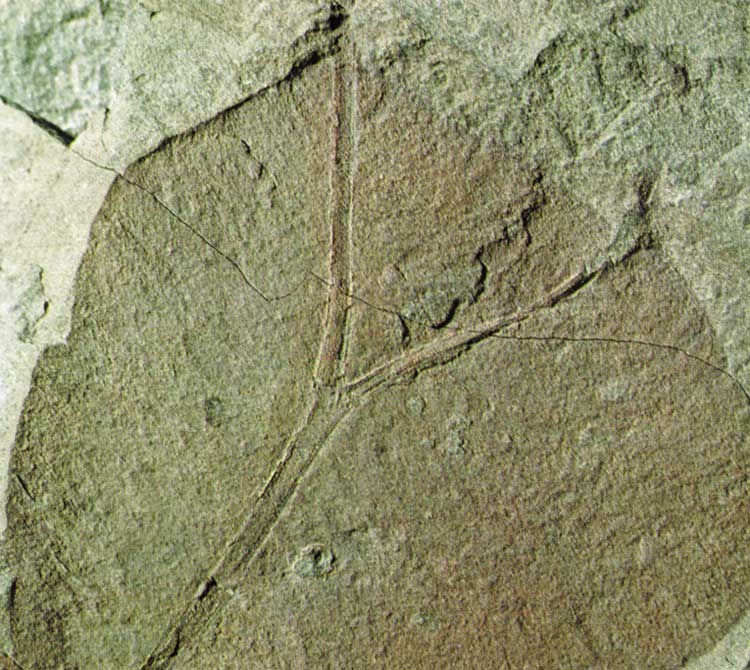 |
Psilophyton |
| This plant, which lived 395-360 million years before our time, has no leaves. As can be seen in the fossil, it was a vascular plant whose branches subdivide dichotomously, but also display lateral ramifications. 88 |
When we look at fossils from this period, we see that they possess many features possessed by plants of our own time. For example, stomata, cuticle, rhizome, and sporangia are just some of the structures fo und in th ese lea v es .8 8 A l an d pl an t mu st be f ul ly prote ct ed from t he danger of drying up if it is to live on the land. The cuticle is a waxy s t ru c t u re w hi ch c o ats th e st em s, br anc hes an d le ave s to p rote c t pl an ts against drying up. If a plant does not have cuticle to prevent drying up, then it has no time to wait for cuticle to develop, as evolutionists claim. If a plant has cuticle layer it lives, if not, it dries up and dies. The difference is that sharp. All the structures plants possess are of vital importance, just l i ke th e c u t i c l e . F o r a p l a n t t o l i ve a n d re p r o d u ce , i t h a d t o p o s s e s s perfectly functioning systems, just like today. From this point of view, all the fossil plants that have been found and all those in the world today confirm that they have possessed the same flawlessly functioning structures from the moment they came to be right up to the present day.
The most important feature of the Carboniferous Age is that many m o re f oss il s hav e b e en fo un d dat in g ba ck t o i t. T here i s no diff e re n c e between species of plants from this period and plants living today. The di ve r si ty su dd e nl y re v ea led i n th e f os si l re c o rd p u t ev ol ut ion i st s int o another difficulty. Because, all of a sudden, species of plants emerged, all of which possessed perfect systems.
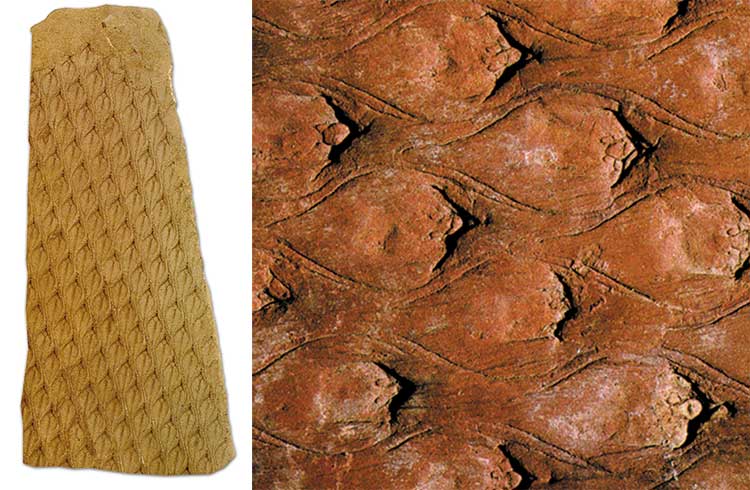 |
Lepidodendron |
| Lepidodendron is a plant that lived 345-270 million years before our day. Fossilized stems of Lepidodendron (above) show that they were covered with leaves, because the scars left when they died are clearly visible. Even the places where the vascular bundles passed from the stem into the leaf stalk can be seen in the centre of the diamond-shaped leaf scars. 89 |
Evolutionists found a way out of this dilemma by inventing a name which went along with evolution, and called this the "Evolutionary Explosion." Of course, calling this phenomenon the "Evolutionary Explosion" solves none of the evolutionists' problems. The problem even left the founder of the theory, Charles Darwin, stunned, and he admitted as much as follows:
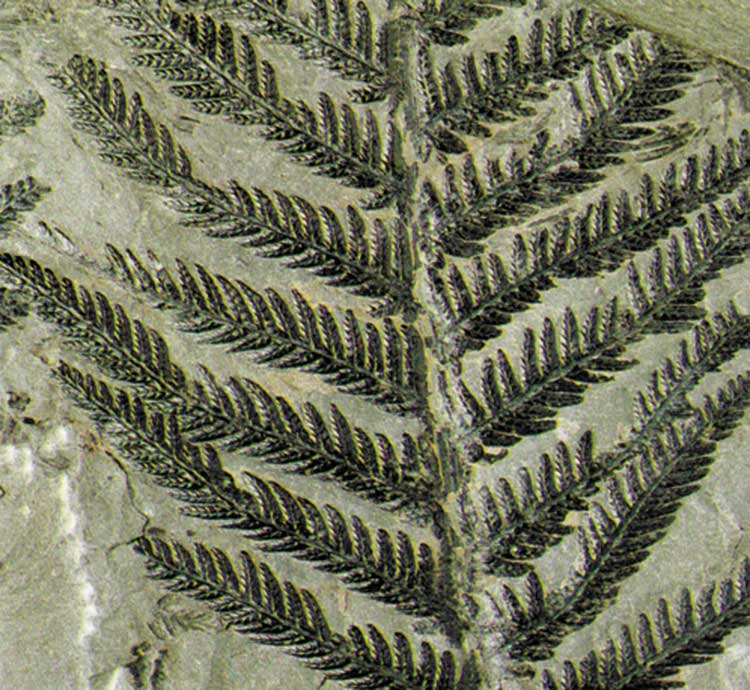 |
Senftenbergia |
| The special feature of this plant is that it possessed leaves composed of pinnules attached to the mainstem. Senftenbergia Plumosa, seen in the picture, was a plant from the German Carboniferous Age (300 million years ago). 90 |
Nothing is more extraordinary in the history of the Vegetable Kingdom, as it seems to me, than the apparently very sudden or abrupt development of the higher plants.91
As we have seen in all these fossil plants, there is no difference in shape or structure between plants of our dayand those which lived hundreds of millions of years ago.
Plants used to carry out photosynthesis billions of years ago, just as they do today. They possessed hydraulic systems strong enough to crack c o n c rete, pump s ab le to t ran sport the wat er a bsorbed from the gro u n d meters high into the air, and chemical factories producing food for living creatures. God, the Lord of all the worlds, who created them, is still creating them today. Even using the most highly developed means offered by modern technology, it is not possible for man, who is trying to understand these miracles of creation in plants, to create even one species of plant out of nothing.
God draws attention to this truth in Surat an-Naml:
He created the heavens and the earth and sends down water from the sky by which We make luxuriant gardens grow. Try as you may, you could never make such trees grow. Is there another deity besides God? No indeed, but they are people who equate others with Him! (Surat an-Naml: 60)
 |
Sphenopteris |
| This was a plant with a complex structure. The leaves of this fossil plant, which seems externally to be no different from to plants of our own time, can be very clearly seen in the fossil. The example in the photograph belongs to the German Carboniferous. 92 |
Neuropteris |
| This is a fossil of the leaves of the species known as Neuropteris . Neuropteris is a plant which lived in the Upper Carboniferous Age (280 million years ago). It is very widespread in European and North American strata. The specimen in the picture belongs to the species N. gigantea . It was unearthed in the Pennsylvanian stratum in Mazon Creek, Illinois. 93 |
Annularia |
| Fossil remains of the leaves of the family Calamitaceae . The leaves are either oval or lance- shaped. This species was common in the U.S., Canada, China and Europe in the Carboniferous Age. It was also common in Russia, and China in the Permian Age, and in Patagonia in the Upper Paleozoic. The specimen in the picture is from the Italian Upper Carboniferous. 94 |
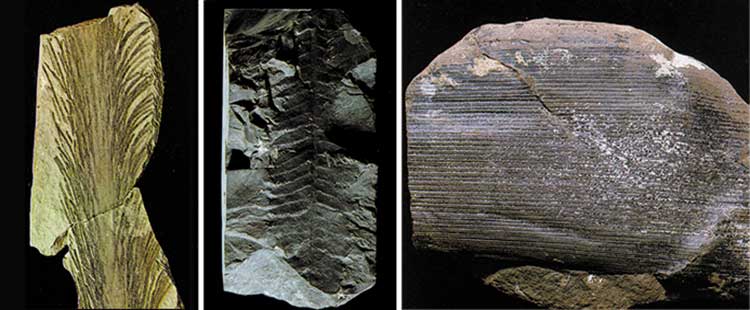 |
BaragwanathiaBaragwanathia is one of the oldest vascular land plants. It had conductor tissues and spores. These are features that make it no different from plants of our own day. Its branches, with leaves, measure up to 28 centimetres long. The branches are 1- 2 centimetres wide. The main axis is split into two secondary axes. It belongs to the Upper Silurian strata (400 million years ago). 95 ZamitesThis genus is used to indicate the fossil remains of cycad fronds. These distinctive leaves of the pinnate type, composed of a central axis from which emerge two rows of elongate leaves. It can be seen that there is no difference from the cycad fronds of our own time. The example in the photograph comes from the Lower Jurassic (190 million years ago), at Osteno, Lombardy (Italy). 96 CalamitesThis was quite a widespread species from the Middle Carboniferous to the Upper Permian Age (300-250 million years ago) and is estimated to have grown up to 20 metres high. 97 |
 |
Auracarian Cone |
| Period: Cretaceous |
| Fossils of living things that lived millions of years in the past show that living things never evolved and that the theory of evolution is devoid of any supporting evidence and a totally invalid theory. With their complex equipment and characteristics unique to their own species, living things that lived millions of years ago, and those living today, are all miracles created by Allah. |
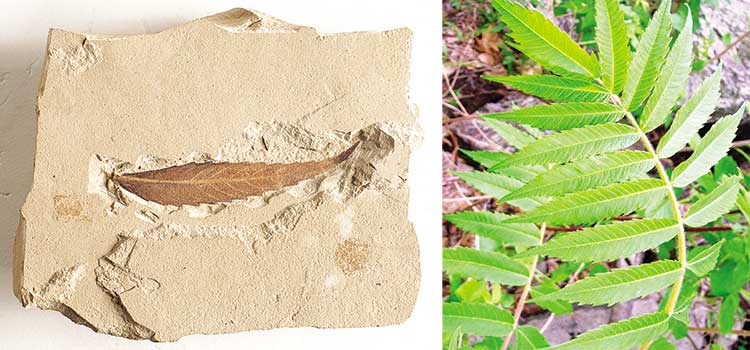 |
Sumac Leaf |
| Period: Eocene |
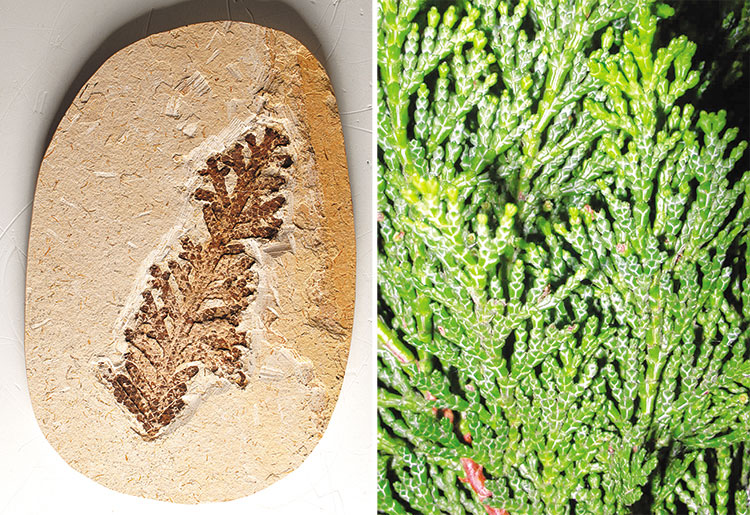 |
Conifer Twig |
| Period: Cretaceous |
 |
Poplar Leaf |
| Period: Eocene |
| Hundreds of plant species appear suddenly in the fossil record, with all their characteristics. And this is a huge problem for evolutionists, one they can never account for. Indeed, this problem baffled Charles Darwin, the founder of the theory of evolution, who admitted: “Nothing is more extraordinary in the history of the Vegetable Kingdom, as it seems to me, than the apparently very sudden or abrupt development of the higher plants.” (Francis Darwin, The Life and Letters of Charles Darwin, 1887, p. 248) |
62. W.R. Bird, The Origin of Species, Revisited, Nashville: Thomas Nelson Co. 1991, p.298-299
63. Alexander I. Oparin, Origin Of Life, (1936) New York, Dover Publications, 1953, p.196
64. Mahlon B. Hoagland, The Roots of Life, Houghton Mifflin Company, 1978, p.18
65. Prof. Dr. Ali Demirsoy, Kalitim ve Evrim (Inheritance and Evolution), Ankara, Meteksan Yayinlari, p.79
66. Prof.Dr. Ilhami Kiziroglu, Genel Biyoloji (General Biology), Desen Yayinlari, p.22
67. Robart A. Wallace, Gerald P. Sanders, Robert J. Ferl, Biology: The Science of Life, Harper Collins College Publishers, p.283
68. Darnell, Implications of RNA-RNA Splicing in Evolution of Eukaryotic Cells, 202 Science 1257 (1978)
69. Prof. Dr. Ali Demirsoy, Kalitim ve Evrim (Inheritance and Evolution), Meteksan Yayinlari, Ankara, p.79
70. W.R. Bird, The Origin of Species Revisited, Nashville: Thomas Nelson Co. 1991, p.210
71. Robart A. Wallace, Gerald P. Sanders, Robert J. Ferl, Biology: The Science of Life, Harper Collins College Publishers, p.94
72. Mahlon B. Hoagland, The Roots of Life, Houghton Mifflin Company, 1978, p.145
73. Whitfield, Book Review of Symbiosis in Cell Evolution, 18 Biological J. Linnean Soc. 77-79 (1982)
74. Milani, Bradshaw, Biological Science, A molecular Approach, D.C.Heath and Company, Toronto, p.158
75. David Attenborough, Life on Earth, Princeton University Press, Princeton, New Jersey, 1981, p.20
76. Prof. Dr. Ali Demirsoy, Kalitim ve Evrim (Inheritance and Evolution), Ankara, Meteksan Yayinlari, 1984, p.8
77. Hoimar Von Ditfurth, Im Amfang War Der Wasserstoff, p.60-61
78. www.faithmc.org.sg/html/creation/htm
79. Hoimar Von Ditfurth, Im Amfang War Der Wasserstoff, p.199
80. R. Shapiro, Origins: A Skeptic’s Guide to the Creation of Life on Earth, 1986, p.90-91
81. Daniel Axelrod, Evolution of the Psikophyte Paleoflora, 13 Evolution, 1959, 264-274
82. Chester A Arnold, An Introduction to Paleobotany, Mc Graw-Hill, 1947, p.334
83. Ranganathan, B.G. Origins?, Carlisle, PA: The Banner of Truth Trust, 1988. p.20
84. Chester A. Arnold, An Introduction to Paleobotany, New York: Mc Grow-Hill, 1947, p.7
85. Daniel Axelrod, The Evolution of Flowering Plants, in The Evolution Life, 1959, p.264-274
86. «Ancient Alga Fossil Most Complex Yet», Science News, vol. 108, September 20 1975, p. 181
87. Dr. Eldred Corner, Evolution in Contemporary Botanical Thought, Chicago: Quadrangle Books, 1961, p.97
88. Ardvini, Teruzzi, Simon&Schuster’s, Guide to Fossils, New York, 1986, pic.no.3
89. Ardvini, Teruzzi, Simon&Schuster’s, Guide to Fossils, New York, 1986, pic.no.6 ve Malcolm Wilkins, Plantwatching, New York, Facts on File Publications, s.26
90. Ardvini, Teruzzi, Simon&Schuster’s, Guide to Fossils, New York, 1986, pic.no.11
91. Francis Darwin, The Life and Letters of Charles Darwin, 1887, s. 248
92. Ardvini, Teruzzi, Simon&Schuster’s, Guide to Fossils, New York, 1986, pic.no.12
93. Ardvini, Teruzzi, Simon&Schuster’s, Guide to Fossils, New York, 1986, pic.no.14
94. Ardvini, Teruzzi, Simon&Schuster’s, Guide to Fossils, New York, 1986, pic.no.10
95. Ardvini, Teruzzi, Simon&Schuster’s, Guide to Fossils, New York, 1986, pic.no.4
96. Ardvini, Teruzzi, Simon&Schuster’s, Guide to Fossils, New York, 1986, pic.no.15
97. Ardvini, Teruzzi, Simon&Schuster’s, Guide to Fossils, New York, 1986, pic.no.9